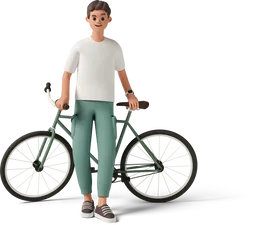
Hey there parents! If you’re reading this, you’re probably wondering when is the right time to take those training wheels off your kiddo’s bike.
I feel you – it’s a tricky decision!
As a parent myself, I totally get how nerve-wracking it can be.
But have no fear, this guide is here to walk you through everything you need to know about taking those extra wheels off and letting your child ride free.
Table of Contents
The most common age that kids learn to ride a two-wheeler is between 5 and 7 years old.
But every child is different!
Some kids master balancing on just two wheels as young as 3 or 4, while others need a bit more time and don’t get the hang of it until age 8 or 9.
There’s no set-in-stone “perfect age” for ditching the training wheels.
The most important factors are your individual child’s coordination, confidence, and readiness.
Don’t rush into it based on what their friends are doing or what some chart says.
Pay attention to your child’s skills and let that guide you.
How can you tell if your kiddo is ready for a big kid bike?
Here are some signs to look for:
If you notice a bunch of these signs emerging, there’s a good chance your little one is ready to try two wheels!
For many kids, the mental hurdle of riding without training wheels can be just as challenging as the physical skills.
They might feel scared or unsure at first.
There are a few things you can do to boost their confidence before the big day:
The more you can do to make them feel capable beforehand, the better their chances of a smooth transition to a two-wheeler!
Lots of parents wonder if kids as young as 4 can skip the training wheels.
The short answer – it’s possible, but tricky!
At age 4, most kids are just developing physical coordination and balance skills.
So it can be super challenging for them to go straight to a regular pedal bike without training wheels.
That said, some precocious 4-year-olds totally have the ability to figure it out, especially if they’ve had practice on a balance bike.
Here are some things to consider if you want to try teaching a 4-year-old to ride without training wheels:
While it won’t work for every 4-year-old, ditching training wheels isn’t impossible at this age with the right bike fit, practice space, support, encouragement, and patience!
We’ve established the average range is between 5 and 7 years old.
But you might be wondering, is there an optimal age that’s best for removing the training wheels?
Here’s a quick rundown of the pros for taking them off at different ages:
Pros:
Potential challenges:
Pros:
Potential challenges:
Pros:
Potential challenges:
So while 5-6 tends to be the sweet spot for many kids, you know your child best.
Pay attention to their development and let that guide your training wheel timing.
Once you decide it’s time to start the transition process, here are some tips:
With the right setting, support crew, transition process and encouragement, you’ll be sending them riding off sans training wheels in no time!
It may take a few weeks, but the payoff of seeing that proud smile when they succeed is priceless.
Some bike-savvy parents wonder if it’s actually better to skip training wheels altogether.
There are benefits to both approaches:
Skipping them:
Using them first:
There’s no universally superior choice.
It depends a lot on your child’s temperament and coordination level.
Adventurous, daring kids will probably take right to a two-wheeler.
More timid children may benefit from the stability of training wheels initially.
If your child is struggling past age 5 with training wheels on flat ground, that’s usually a sign it’s time to take them off.
The training wheels may be hindering rather than helping at that point.
But for kids who are still a bit wobbly, no shame in keeping them on a bit longer until skills improve!
No matter which method you choose, the most important thing is building their confidence, celebrating small victories, and making the experience fun rather than pressured.
With your support, they’ll be cruising the neighborhood on two wheels in no time!
Watching your child ride solo for the first time is a proud parenting moment for sure!
As nerve-wracking as the training wheel transition can be, remember that every kid learns at their own pace.
Trust your instincts, be patient in the process, and they’ll get there.
Riding a bike is a rite of passage that can bring a lifetime of joy, freedom, and fond memories.
By teaching kids to balance on their own, we’re giving them confidence, independence and a skill that can last forever.
Keep that bigger picture in mind as you guide them through this exciting milestone.
Well, that covers the basics on moving to “big kid bikes!”
I hope this info helps you decide when the timing is right for your little one.
Wishing you many happy hours of neighborhood bike adventures ahead. Pedal on!
